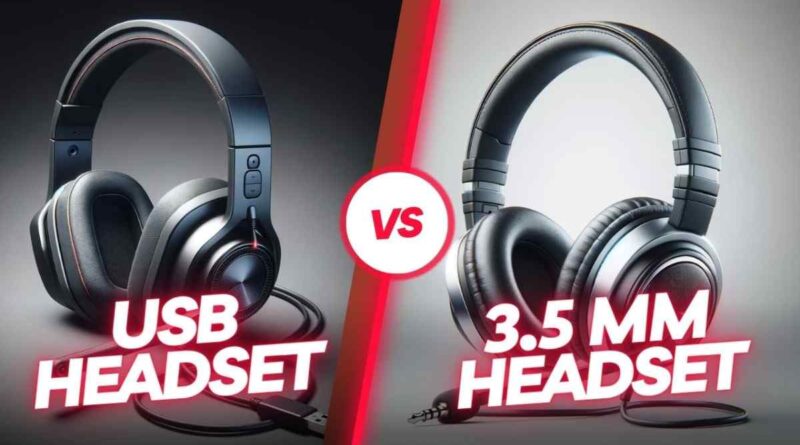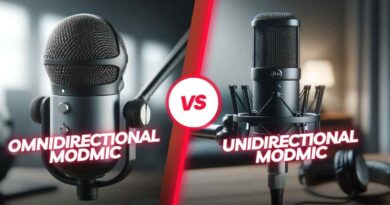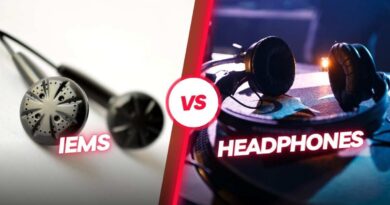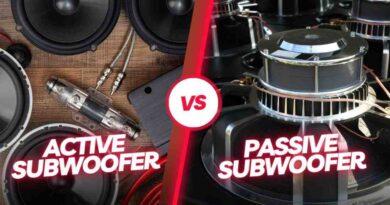USB Vs. 3.5 mm Headset: Which Is Better?
When it comes to choosing the right headset, the decision often boils down to selecting between USB and 3.5 mm options. Each type has its own set of advantages and specifications that can significantly impact your audio experience. In this blog, I will provide a detailed comparison between USB and 3.5 mm headsets, examining everything from sound quality to compatibility, so you can make an informed decision based on your needs.
USB Vs. 3.5 mm Headset
1. Introduction to USB and 3.5 mm Headsets
USB (Universal Serial Bus) and 3.5 mm headsets represent two of the most common types of connections for audio devices. The 3.5 mm headset, also known as the audio jack, has been a standard in audio connectivity for decades. It provides an analog signal, directly transferring audio from your device to your ears. USB headsets, on the other hand, convert digital signals into sound within the headset itself, which can enhance sound quality and allow for more features like surround sound and enhanced modulation.
Key Takeaway:
- USB headsets convert digital signals internally, potentially enhancing audio quality.
- 3.5 mm headsets offer a direct analog connection, favored for its simplicity and universal compatibility.
2. Sound Quality Comparison
Sound Clarity and Richness
USB headsets generally provide clearer and richer sound than 3.5 mm headsets. This is because USB headsets can process the audio signal digitally and include built-in sound cards with advanced features like noise suppression and equalization. This can result in a more detailed and vibrant sound.
Frequency Response
The frequency response of a headset determines the range of sounds it can reproduce. USB headsets often have a broader frequency range and better sound processing capabilities, which means they can handle both high and low frequencies more effectively.
Impact on Audio Professionals
For audio professionals or enthusiasts, USB headsets may offer a distinct advantage in terms of sound quality. The built-in DAC (Digital-to-Analog Converter) can significantly improve the accuracy of the sound reproduction, essential for tasks like mixing or mastering audio.
Key Takeaway:
- USB headsets often provide superior sound clarity and a broader frequency response.
- The digital processing in USB headsets can offer advantages for audio professionals.
3. Compatibility and Connectivity
Device Compatibility
USB headsets are compatible with any device that has a USB port, which includes most modern computers and laptops. However, they are not typically compatible with devices that only have a 3.5 mm jack unless the device has a USB adapter.
Port Availability
The availability of USB ports can be a limitation for some users. For example, if you are using a laptop with a limited number of USB ports, using one for a headset might restrict your ability to connect other devices. In contrast, the 3.5 mm jack is almost universally available on a wide range of devices, from smartphones to game consoles.
Driver and Software Requirements
USB headsets often require drivers and software to be installed on the device. This can add a layer of complexity in terms of setup, especially for less tech-savvy users. On the other hand, 3.5 mm headsets typically do not require any additional software, offering plug-and-play simplicity.
Key Takeaway:
- USB headsets require a USB port and often need drivers and software to function.
- 3.5 mm headsets offer universal compatibility and simplicity, working with any device that has a headphone jack.
4. Durability and Build Quality
Material and Design
Both USB and 3.5 mm headsets come in a variety of designs and materials. However, the build quality can vary significantly depending on the brand and price point. It is essential to check the durability of the materials used, especially for cables and connectors, which are often the first parts to wear out.
Lifespan and Maintenance
The lifespan of a headset can be influenced by its build quality and how it is used. USB headsets, with their digital components and software, may require more maintenance in terms of software updates. Meanwhile, the simplicity of 3.5 mm headsets often translates to less maintenance and a longer physical lifespan if they are well cared for.
User Handling and Care
Regardless of the type, the longevity of a headset largely depends on how it is handled and stored. Ensuring that cables are not overly bent and that the headset is stored properly when not in use can significantly extend its life.
Key Takeaway:
- Build quality varies by brand and price; check durability features, especially for connectors and cables.
- USB headsets may require more maintenance due to digital components, whereas 3.5 mm headsets generally offer longer physical lifespan with less care.
5. Feature Set and Functionalities
Integrated Controls and Software Features
USB headsets often come with integrated controls and can be paired with software that allows for customization of sound profiles, virtual surround sound, and other advanced settings. These features can enhance the user experience, especially for gaming or multimedia tasks.
Microphone Quality
Another aspect where USB headsets generally excel is in microphone quality. The digital interface allows for better sound processing capabilities, often resulting in clearer voice transmission. This is particularly important for activities like conferencing or online gaming.
Additional Features
Many USB headsets also include features such as noise cancellation, both in the microphone and the earpieces. This technology helps to isolate sound and improve both listening and speaking clarity in noisy environments.
Key Takeaway:
- USB headsets provide advanced features like customizable sound profiles and virtual surround sound.
- They generally offer superior microphone quality and noise cancellation features.
6. Ease of Use and User Experience
Plug-and-Play Functionality
The 3.5 mm headsets offer unrivaled simplicity with their plug-and-play functionality. There’s no need for any software installation, making them immediately usable with almost any device.
Software Integration
While USB headsets require software for most advanced features, this software integration allows for a highly customizable user experience. Users can adjust settings to perfectly match their sound preferences or the acoustic requirements of different environments.
User Learning Curve
For users who are not as tech-savvy, the simplicity of the 3.5 mm headset makes it more appealing. In contrast, the added functionality of USB headsets can come with a learning curve, especially in terms of software usage.
Key Takeaway:
- 3.5 mm headsets are incredibly easy to use, offering immediate functionality without any setup.
- USB headsets provide a customizable experience but may require some learning for optimal use.
7. Portability and Convenience
Physical Size and Weight
Headsets, regardless of connection type, vary in size and weight. However, the internal components required for USB headsets can sometimes make them bulkier compared to their 3.5 mm counterparts.
Travel-Friendliness
For those who travel frequently, the ease of carrying and using a headset is crucial. 3.5 mm headsets are typically more travel-friendly due to their universal compatibility and the absence of a need for software.
Cable Management
Cable management is often easier with 3.5 mm headsets as they usually don’t include additional in-line controls or digital components that add bulk to the cable. USB headsets might offer more features, but this can also lead to a heavier and more cumbersome cable setup.
Key Takeaway:
- 3.5 mm headsets are generally lighter and more compact, making them ideal for travel.
- USB headsets might provide more features but can be bulkier and less convenient for on-the-go use.
8. Cost and Value for Money
Price Range
USB headsets typically come at a higher price point due to the additional technology and features they include. The price can vary widely based on brand, quality, and additional features.
Value for Investment
While USB headsets are more expensive, the investment might be worthwhile for users who need advanced features and better sound processing capabilities. For casual users, however, the additional cost may not provide proportional value.
Budget Considerations
For those on a tight budget, 3.5 mm headsets generally offer a more cost-effective solution. They provide adequate sound quality and functionality for everyday use without a significant financial outlay.
Key Takeaway:
- USB headsets are more costly but offer advanced features and better sound processing.
- 3.5 mm headsets are more budget-friendly and suitable for casual or everyday use.
9. Impact on Mobile and Tablet Use
Compatibility with Mobile Devices
Most mobile phones and tablets are equipped with a 3.5 mm jack, although this is becoming less common with newer models. USB headsets require either a USB-C connection, which is increasingly available on modern devices, or an adapter.
Functionality on Mobile
While USB headsets can provide enhanced audio features even on mobile devices, the need for adapters or specific port types can limit their practicality. The simplicity of 3.5 mm headsets makes them a more convenient choice for mobile users.
Mobile-Specific Advantages
Given the trend of removing 3.5 mm jacks from smartphones, USB headsets are gaining ground in mobile compatibility, especially as more devices embrace USB-C. However, for now, 3.5 mm headsets still offer the easiest and most reliable connection for most mobile users.
Key Takeaway:
- USB headsets are becoming more compatible with modern mobile devices, but often require adapters.
- 3.5 mm headsets remain the most convenient option for mobile use, despite the phasing out of the headphone jack in newer models.
10. Future-Proofing and Technology Trends
Technological Advancements
The trend in audio technology is leaning towards digital solutions, like USB and wireless headsets, which can offer more features and better sound quality. This indicates a potential decrease in the prevalence of 3.5 mm headsets in the future.
Adaptability and Upgrades
USB headsets are better positioned to take advantage of future technological improvements in digital sound processing. This makes them a more future-proof choice for users who prioritize staying at the forefront of technology.
Market Predictions
As technology evolves, the market might favor USB and wireless options, potentially diminishing the relevance of 3.5 mm connections. However, the simplicity and widespread use of the 3.5 mm jack mean it will likely remain a viable option for many users in the near future.
Conclusion
Choosing between USB and 3.5 mm headsets depends largely on your specific needs and usage scenarios. If you are looking for advanced features, superior sound quality, and future compatibility, USB headsets are the way to go. However, for those who value simplicity, universal compatibility, and cost-effectiveness, 3.5 mm headsets remain an excellent choice.
Frequently Asked Questions
Which is better for gaming, USB or 3.5 mm headsets?
USB headsets are better for gaming because they offer superior sound quality and features like virtual surround sound.
Can USB headsets be used on all devices?
No, USB headsets require devices with a USB port or a USB-C port with an adapter for devices that do not have these ports natively.
Are 3.5 mm headsets compatible with all smartphones?
Most older smartphones support 3.5 mm headsets, but newer models might require an adapter.
Which headset type is more durable?
Durability depends more on the brand and build quality than on the type of connection.
Do USB headsets require additional software?
Yes, most USB headsets require drivers or software to fully utilize their features.
What is the cost difference between USB and 3.5 mm headsets?
USB headsets are generally more expensive due to their additional features and technology.
Which headset type is easier for travelers?
3.5 mm headsets are typically more travel-friendly due to their compatibility and ease of use.
Can I use a USB headset with a console like Xbox or PlayStation?
Some USB headsets are compatible with consoles, but check compatibility specifics before purchase.
Are there wireless versions of USB and 3.5 mm headsets?
Yes, there are wireless options for both types, offering different features and price points.
How can I ensure my headset lasts longer?
Proper handling, storage, and care, such as avoiding bending cables and keeping the headset clean, can extend its lifespan.




